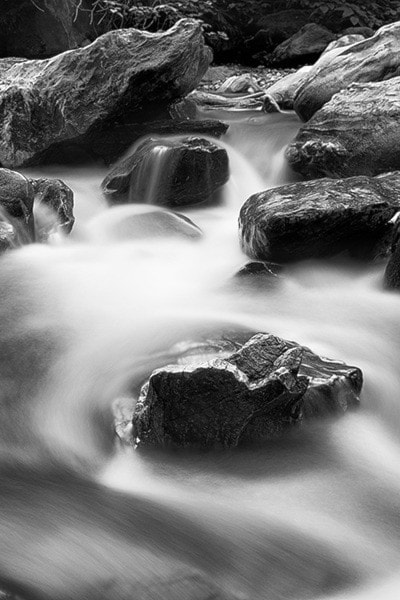A neutral density (ND) filter is a clear, colourless, filter that reduces the intensity of all wavelengths, or colours of light, equally.
It is usually a colorless (gray) filter that reduces the amount of light entering the lens.
A photographer can select exposure combinations that would otherwise produce overexposed pictures.
Using a ND filter allows a photographer to achieve a very shallow depth of field, or motion blur.
I’ll begin by saying quality ND filters have always been expensive. During the days of film, the exposure you made was the exposure you got. And when one used colour film one didn’t get a second chance if there was a colour shift, usually a purple cast, with less expensive filters. Some cheap filters weren’t all that sharp either.
I thought about that when during a workshop the leader loaned me a couple of Lee filters (over a hundred dollars each) to try on long exposures of the waterfall we were photographing. He indicated if I were to order through him I could get a discount.
I’d already spent a bundle on costs including travel and lodging, and owned ND filters that worked well, so I passed on the deal and came home thinking about maybe a future purchase.
My memory of ND filter problems were from the time of film. Film has a permanence that data files created in our modern digital camera don’t have.
Colour balance in film means colour correction filters. Where as, with digital I mostly leave my camera on auto white balance, and fix any shift when I open my RAW files in Photoshop.
A photographer could somewhat help a soft image when shooting black and white film by increasing the contrast, but with colour it was permanent.
Nowadays, we have a number of software possibilities that can almost (well, almost) fix a not-quite-in-focus image.
With all that in mind, I thought that unless I was making very large prints. those cheap ND filters might be usable. So I ordered several very inexpensive, no-name ND filters thinking the $60.00 or so I spent might be foolish, but I’d have some fun and discard them if they didn’t work.
I bought them, put them away and forgot about them. Then this past week as I sat looking at the overcast sky after a much-needed shower in the parched hills around my home, I decided to give those filters a try. I grabbed my camera, tripod, and the bag of filters, talked my wife into coming, and drove to a local waterfall.
The Chase Creek falls weren’t the raging torrent of spring or early summer. This year’s long, hot, dry spell has had an effect and capturing an exciting waterfall wasn’t possible.
I tried a couple of different angles, scrambling around the rocks and down to a now sandy shore, and then a group of young people came to splash in the cold water so I moved downstream in the creek.
I was getting bored anyway and didn’t mind giving up my spot to those kids and their blanket.
Returning home, I loaded my RAW files in the computer, easily corrected the white balance, added contrast and sharpened the image in Photoshop.
My conclusion is those inexpensive ND filters are great if one is willing to shoot in RAW and make post-production corrections. I think an out-of-the-camera JPG would be disappointing.
I expect there will be opinions by experienced photographers who read this. However, the images look pretty good on my calibrated 30-inch Mac display screen.
I haven’t made any prints, but I expect 8x10’s might be just fine, and if just sharing images on-line I think inexpensive ND filters will be fine.
These are my thoughts for this week. Contact me at www.enmanscamera.com or emcam@telus.net. Stop by Enman’s Camera at 423 Tranquille Road in Kamloops. And if you want an experienced photographer please call me at 250-371-3069. I also sell an interesting selection of used photographic equipment.
